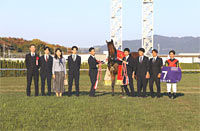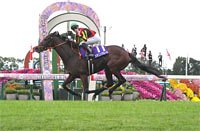2015 News
Data Analysis for the "2015 Queen Elizabeth II Cup (G1)"Strong and beautiful fillies line up to decide the autumn queen title The Queen Elizabeth II Cup is the autumn’s biggest race to decide the top fillies and mares – a matchup between the 3-year-olds coming from the Fillies Triple Crown and 4-year-olds and up challenging from a number of step races. Over the last 10 years, 3-year-olds have been in the van with five wins, compared to three for 4-year-olds and two for 5-year-olds. Let’s look at some trends in this race to see if we can predict successful runners from results over the last 10 years. Check the runners’ favoritism in the previous race First, let’s look at aggregate performances by runners over the last 10 years in terms of their favoritism to win in their most recent race (except when it was overseas). Fillies backed as “4th favorite” last time out have the best win ratio in this race, followed by those with “6th-9th favorite” tags. Excluding UK-trained Snow Fairy (winner in 2010 and 2011, coming straight from overseas races), six of the other eight winners had been 4th favorite or lower in their previous race. Runners backed as “1st favorite” last time out have achieved four 2nd and six 3rd place finishes but no winners in this race. When looking for winners, it seems a good idea to check the runners’ favoritism in their previous race. [Table 1] [Table 1] Performance by favoritism to win in the previous race (last 10 years)
Look for experience in fillies graded races since the summer season Turning to performances by experience of competing in that year’s Queen Stakes, Fuchu Himba Stakes or Shuka Sho, runners in the “Shuka Sho only” and “None entered” groups have fared comparatively well over the last 10 years. It may come as a surprise that fillies and mares aged 4 and up that did not run in the Queen Stakes (part of the summer Hokkaido series) or the Fuchu Himba Stakes (the principal prep race for this race) have performed better than their counterparts. [Table 2] [Table 2] Performance by experience of competing in that year’s Queen Stakes, Fuchu Himba Stakes or Shuka Sho (last 10 years)
Take a good look at the recent track record Next, let’s check the runners’ records in the most recently contested turf 2,000-2,200m race within the last 3 outings – or, if beaten to 2nd or lower, the time difference behind the winner. Over the last 10 years, the better performers in this race have been those finishing “1st in the race in question” and those trailing the winner by “0.3 seconds or less.” By contrast, those finishing “0.4-0.5 seconds” or “0.6 seconds or more” behind the winning horse have only produced one runner-up in the past 10 years. It may pay to scrutinize the runners’ showings in their most recently contested turf 2,000-2,200m race. [Table 3] [Table 3] Performance by time difference behind the winner in the most recently contested turf 2,000-2,200m race within the last 3 outings (last 10 years)
Check recent finishes in mixed races Now, let’s look at this race’s runners from the past 10 years and their performances in mixed races (colts and horses) within their last four outings. Those that came in “1st” or “2nd-4th” have produced the best success ratios in this race. Clearly, we should not easily dismiss any runner that has recently competed in mixed races with colts and horses and achieved a high placing. But the “No such race entered” group has produced 4 winners, all of which were 3-year-olds – another thing to bear in mind. [Table 4] [Table 4] Performance by highest finish in mixed races within the last four outings (last 10 years)
Seek out the winner! Of the seven winners since 2006 (excluding UK-trained Snow Fairy, which won the race back-to-back in 2010 and 2011), six had finished higher than their favoritism in their previous outings and one had finished in the same position as her favoritism. When looking for potential winners, it might be worth checking for runners with this kind of record in their previous contest. [Table 5] [Table 5] Comparison of winners’ favoritism and finish in their previous race (since 2006)
(Data analysis by Michio Kawano) |
|
|||||||||||||||||||||||||||||||||||||||||||||||||||||||||||||||||||||||||||||||||||||||||||||||||||||||||||||||||||||||||||||||||||||||||||||||||||||||||||||



















